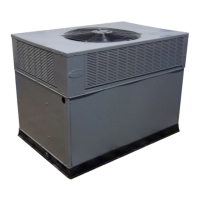48GP, 48GPN
Single Package Gas Heating/Electric Cooling Units
With Puron® (R-410A) Refrigerant
Installation, Start-Up, and Operating Instructions
48GP, 48GPN Sizes 024-060
NOTE: Read the entire instruction manual before starting the
installation.
Index Page
SAFETY CONSIDERATIONS.....................................................1
RULES FOR SAFE INSTALLATION AND OPERATION....1-2
RECEIVING AND INSTALLATION ..........................................2
CHECK EQUIPMENT ..................................................................2
PROVIDE UNIT SUPPORT.........................................................2
Roof Curb ............................................................................2
Slab Mount ..........................................................................2
Ground Mount .....................................................................2
FIELD FABRICATE DUCTWORK.............................................2
PROVIDE CLEARANCES........................................................2-3
RIG AND PLACE UNIT.......................................................3, 6-7
CONNECT CONDENSATE DRAIN ...........................................7
INSTALL FLUE HOOD ...............................................................7
INSTALL GAS PIPING.............................................................7-8
INSTALL DUCT CONNECTIONS .......................................8, 10
INSTALL ELECTRICAL CONNECTIONS.........................11-13
High-Voltage Connections ................................................11
Special Procedures for 208-V Operation..........................11
Control Voltage Connections............................................12
Standard Connection..........................................................12
Heat Anticpator Setting.....................................................13
Transformer Protection......................................................13
PRE-START-UP ..........................................................................13
START-UP..............................................................................13-22
MAINTENANCE....................................................................22-26
REFRIGERANT SYSTEM..........................................................26
QUICK REFERENCE GUIDE....................................................27
TROUBLESHOOTING..........................................................28-30
START-UP CHECKLIST............................................................31
NOTE TO INSTALLER — Before the installation, READ
THESE INSTRUCTIONS CAREFULLY AND COMPLETELY.
Also, make sure the User’s Manual and Replacement Guide are
left with the unit after installation. the furnace is NOT to be used
for temporary heating of buildings or structures under construc-
tion.
SAFETY CONSIDERATIONS
Installation and servicing of air-conditioning equipment can be
hazardous due to system pressure and electrical components. Only
trained and qualified personnel should install, repair, or service
air-conditioning equipment.
Untrained personnel can perform basic maintenance functions of
cleaning coils and filters. All other operations should be performed
by trained service personnel. When working on air-conditioning
equipment, observe precautions in the literature, tags and labels
attached to the unit, and other safety precautions that may apply.
Follow all safety codes. Wear safety glasses and work gloves. Use
quenching cloth for unbrazing operations. Have fire extinguisher
available for all brazing operations.
RULES FOR SAFE INSTALLATION AND OPERATION
Improper installation, adjustment, alteration, service, mainte-
nance, or use can cause carbon monoxide poisoning, fire, or
an explosion which can result in serious injury or unit
damage. Consult a qualified installer, service agency, or gas
supplier for information or assistance. The qualified installer
or agency must use only factory-authorized kits or accessories
when modifying this product.
Understand the signal words —DANGER, WARNING, and
CAUTION. DANGER identifies the most serious hazards which
will result in severe serious injury or death. WARNING indicates
a condition that could result in serious injury or death. CAUTION
is used to identify unsafe practices which would result in minor or
moderate injury or product and property damage.
The power supply (volts, phase, and hertz) must correspond to that
specified on unit rating plate.
The electrical supply provided by the utility must be sufficient to
handle load imposed by this unit.
This installation must conform with local building codes and with
NEC (National Electrical Code) and NFPA 70, NFPA 54/ANSI
Z223.1 latest revision, and NFGC (National Fuel Gas Code). Refer
to provincial and local plumbing or waste water codes and other
applicable local codes.
Approved for outdoor installation on wood flooring or on class A,
B or C roof covering materials.
Fig. 1—Unit 48GP
C99088
Visit www.carrier.com
Manufacturer reserves the right to discontinue, or change at any time, specifications or designs without notice and without incurring obligations.
Book 1 4
Tab 6a 8a
PC 101 Catalog No. 534-755 Printed in U.S.A. Form 48GP-1SI Pg 1 3-00 Replaces: New

